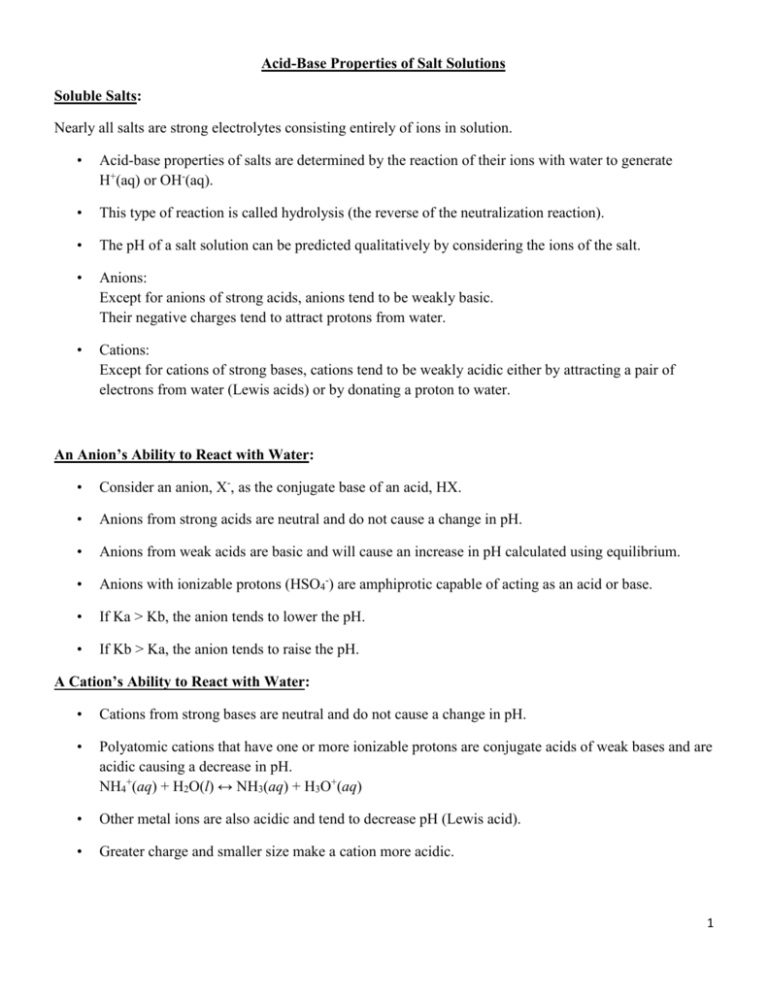Acid-Base Properties of Salt Solutions Soluble Salts: Nearly all salts
advertisement

Acid-Base Properties of Salt Solutions Soluble Salts: Nearly all salts are strong electrolytes consisting entirely of ions in solution. • Acid-base properties of salts are determined by the reaction of their ions with water to generate H+(aq) or OH-(aq). • This type of reaction is called hydrolysis (the reverse of the neutralization reaction). • The pH of a salt solution can be predicted qualitatively by considering the ions of the salt. • Anions: Except for anions of strong acids, anions tend to be weakly basic. Their negative charges tend to attract protons from water. • Cations: Except for cations of strong bases, cations tend to be weakly acidic either by attracting a pair of electrons from water (Lewis acids) or by donating a proton to water. An Anion’s Ability to React with Water: • Consider an anion, X-, as the conjugate base of an acid, HX. • Anions from strong acids are neutral and do not cause a change in pH. • Anions from weak acids are basic and will cause an increase in pH calculated using equilibrium. • Anions with ionizable protons (HSO4-) are amphiprotic capable of acting as an acid or base. • If Ka > Kb, the anion tends to lower the pH. • If Kb > Ka, the anion tends to raise the pH. A Cation’s Ability to React with Water: • Cations from strong bases are neutral and do not cause a change in pH. • Polyatomic cations that have one or more ionizable protons are conjugate acids of weak bases and are acidic causing a decrease in pH. NH4+(aq) + H2O(l) ↔ NH3(aq) + H3O+(aq) • Other metal ions are also acidic and tend to decrease pH (Lewis acid). • Greater charge and smaller size make a cation more acidic. 1 Classifying a salt solution as acidic, basic, or neutral: • disregard any neutral cations or anions. • If what remains is an anion, the salt is basic. • If what remains is a cation, the salt is acidic. • If both the cation and anion are from a strong acid and a strong base, the salt is neutral. • If neither the cation nor anion are neutral, the acid/base character of the salt cannot be from the formula. • Charged cations in solution are Lewis acids. • The higher the charge, the more acidic the solution. • For equal charges, the smaller cation is more acidic. • The higher the charge of the anion, the more basic. determined Effect of Cation and Anion in Solution: The pH of a solution may be qualitatively predicted using the following guidelines: • Salts derived from a strong acid and a strong base are neutral. Example: NaCl and Ca(NO3)2. • Salts derived from a strong base and a weak acid are basic. Example: NaClO and Ba(C2H3O2)2. • Salts derived from a strong acid and a weak base are acidic. Example: NH4Cl. • Salts derived from a weak acid and a weak base can be either acidic or basic. • Equilibrium rules apply! Compare Ka and Kb for hydrolysis of the anion and the cation. • For example, consider NH4CN. Both ions undergo hydrolysis. Is the salt solution acidic or basic? • Probably basic because of “N”. Actually, the Ka of NH4+ is smaller than the Kb of CN–, so the solution is basic. 2 Summary: Soluble Salts Structure and Acid Base Properties: • Anions have a tendency to form bases and increase pH. • Cations have a tendency to form acids and decrease pH. • Binary acids: acid strength increases left to right across a period as the H−X bond polarity increases (becomes more electronegative). • Acid strength increases as you go down a group (bond strength decreases as size increases). Acidity and Bond Strength 3 Factors Affecting Acid Strength • The more polar the H-X bond (across a period) and weaker the H-X bond (down a group), the more acidic the compound. • Acidity increases from left to right across a row and from top to bottom down a group. Structure and Acid Base Properties: Oxyacids: acids containing O−H on a central atom. • Acid strength increases as electronegativity of the central atom increases (HClO > HBrO). • Acid strength increases as the number of attached O’s increase (HClO3 > HClO2). 4 Oxides: A binary compound of oxygen with another element is called an oxide. Oxides may be classified into the following four types: 1) Basic oxides: Alkali, alkaline earth, and transition metals form basic oxides Na2O, MgO, Fe2O3 CaO(s) + H2O(l) → Ca(OH)2(aq) their relative basic character decreases (acidity increases) in the order: alkali metal oxides > alkaline earth metal oxides > transition metal oxides. 2) Acidic oxides: Non-metal oxides are generally acidic: CO2, SO2, SO3, NO2, N2O5, P4O10, Cl2O7, etc. P4O10 + 6H2O → 4H3PO4 3) Amphoteric oxides: Al2O3, SnO2, etc. with acid: Al2O3 + 3H2O + 6H3O+(aq) → 2[Al(H2O)6]3+(aq) with base: Al2O3 + 3H2O + 2OH-(aq) → 2[Al(OH)4]-(aq) 4) Neutral oxides: All neutral oxides are monoxides, i.e. H2O, CO, N2O, NO, etc. Trends of oxides: oxides become more acidic as the electronegativity of the central atom increases (left to right across a row and bottom to top up a group): i.e. third period. Na2O MgO Al2O3 SiO2 Strongly basic amphoteric weakly basic acid P4O10 SO2 Cl2O7 acidic strongly acidic Very strongly acidic Basic to acidic character increases 5 B2O3 acidic • Moving up a group, acidic character of the oxides increase becoming less basic (group 13): Al2O3 amphoteric Ga2O3 (weakly basic) In2O3 basic Tl2O3 basic Oxides of the representative elements in their highest oxidation states: 6 Carboxylic Acids: Carboxylic acids: organic acids with a functional group, −COOH. Trends: look at the attached R group: • If R is a simple hydrocarbon chain, there is very little effect on acid strength: i.e. CH3COOH (Ka = 1.8 x 10-5), CH3(CH2)3COOH (Ka = 1.5 x 10-5) • Acidity increases, if R contains a highly electronegative element and continues to increase as the number of electronegative elements increase as well as their closeness to −COOH. ICH2CH2COOH Ka = 8.3 x 10-5 ClCH2CH2COOH Ka = 1.0 x 10-4 CH2CHClCOOH Ka = 1.4 x 10-3 CH3CCl2COOH Ka = 8.7 x 10-3 Amines: • Amines: organic derivatives of ammonia in which one or more of the ammonia hydrogens are replaced by alkyl or aromatic groups. • Amines are weak bases that react with water to produce hydroxide ions (OH-) and acids to form salts. • Trends: primary (RNH2) and secondary (R2NH) amines are stronger bases than tertiary amines (R3N). • Aromatic amines are weaker bases than aliphatic amines (straight line and cyclic). Summary: 1.) ALL acids and bases have Ka/Kb values. However, for strong acids and bases the equillibrium is so far to the right that the Ka/Kb value is extraordinarily high. (Similar to equillibrium constants. All reactions have an equillibrium constant. Some reactions are so heavily favored towards the products side that we make the assumption that at equillibrium all the reactants have reacted). 2.) A salt will form a basic solution if the anion is that of a weak acid. It will form an acidic solution if the cation is that of a weak base. a) NaCl is a neutral salt because the sodium ion is the cation of a strong base (NaOH) and the chloride ion is the anion of a strong acid (HCl). So when it goes into solution, the sodium is not going to pull an OHoff of water and form sodium hydroxide, thus leaving H+ ions in solution and making an acid, and the chlorine is not going to pull an H+ off of water and form HCl, thus leaving a bunch of OH- ions in solution and making a base. Therefore, the solution will be neutral. 7 b) NH4Cl is an acidic salt because when it goes into solution, the NH4+ is going to pull some OH- ions from water and form the weak base NH4OH. Since NH4OH is a weak base, it will remain in solution mostly as NH4OH, thus leaving some H+ ions floating around. The presence of the H+ ions makes the solution acidic. c) NaC2H3O2 is a basic salt because the acetate ion will pull an H+ ion from water to form the weak acid CH3COOH (Acetic acid). Since acetic acid is weak, it will mostly remain in water mostly as CH3COOH leaving some OH- ions floating around. The OH- ions make the solution basic. d) With NH4CN you have the cation from a weak base (NH4OH) and the anion from a weak acid (HCN). However, HCN is a weaker acid than NH4OH is a weak base (Kb > Ka). Therefore, the CN- ion will pull more H+ ions from water than NH4+ will pull OH- ions. As a result, there will be more OH- ions present at equillibrium which makes the solution basic. So when you have the conjugate acids and bases of a weak acid and a weak base involved in a salt, the weaker of the two will predominate when determining if a solution is acidic or basic. (In the NH4CN example, HCN is a weaker acid than NH4OH is a weak base (Kb > Ka), so when determining if the solution will be basic or acidic, you disregard the 'stronger' acid/base and make your determination based upon the ion that is leftover. 8








